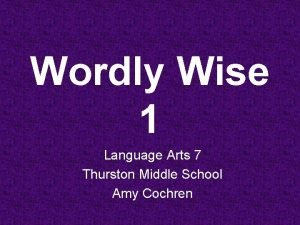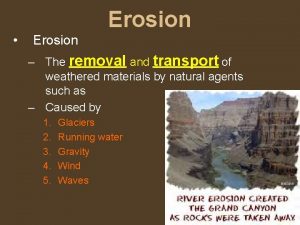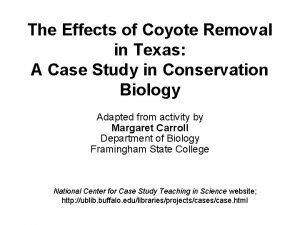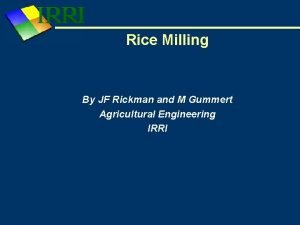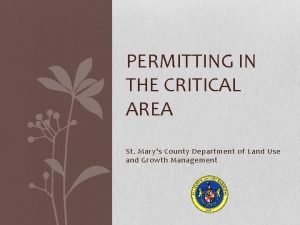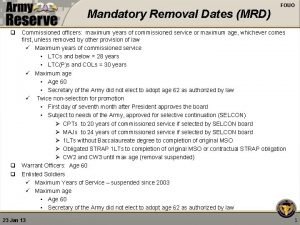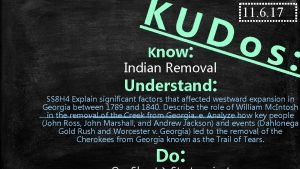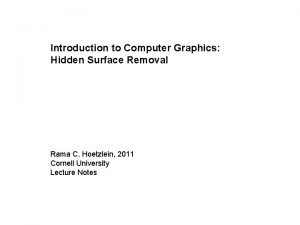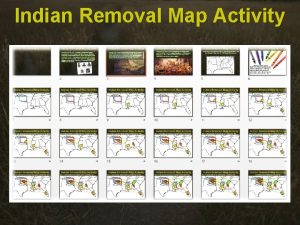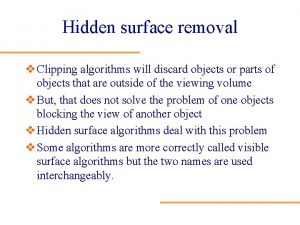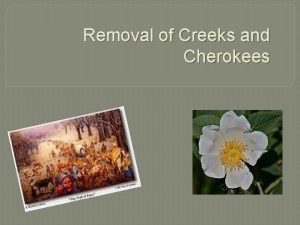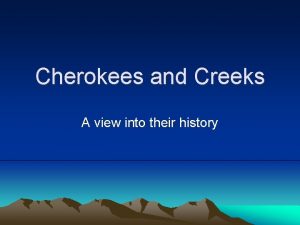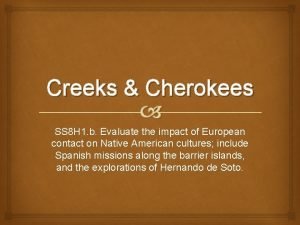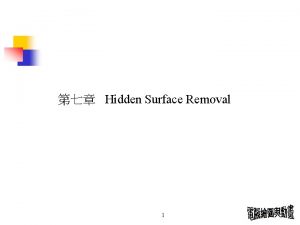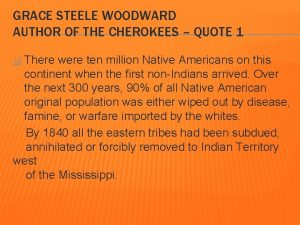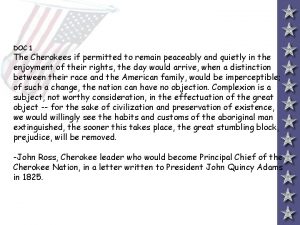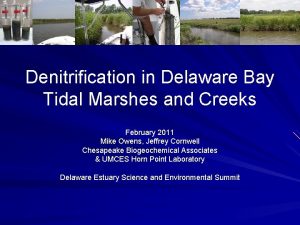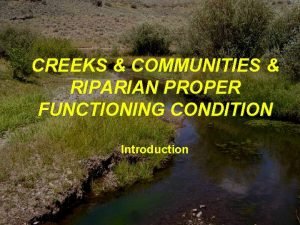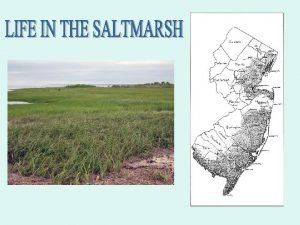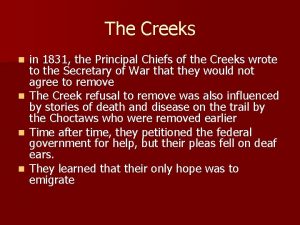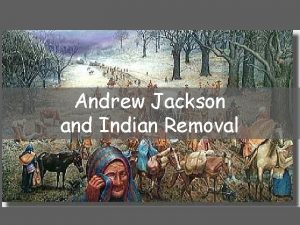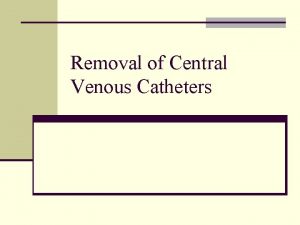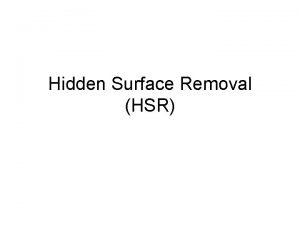Removal of Creeks and Cherokees Removal of Creeks

























- Slides: 25

Removal of Creeks and Cherokees

Removal of Creeks

Alexander Mc. Gillivray � Creek Chief who resisted expansion � Red Sticks’ attack on Fort Mims � Sent warriors to fight frontiersman • Burned houses, stole horses and cattle, and killed or captured over 200 settlers � Signed Treaty of New York • Gave up massive amounts of Creek land in East • Set Creek boundaries at Altamaha and Oconee Rivers • No whites could cross borders and Creeks must return all runaway slaves

William Mc. Intosh � http: //www. gpb. org/georgiastories/story_ of_chief_william_mcintosh � Creek Chief � Nephew of Alexander Mc. Gillivray � Cousin of Georgia Governor George Troup � Signed Treaty of Indian Springs • Sold all remaining Creek land to Georgia Government • Signed with Governor Troup and Chief Mc. Intosh • Loose Creek Confederation led to his murder

Removal of Cherokees http: //www. gpb. org/georgiastories/john_ross

Sequoyah �http: //www. gpb. org/georgiastories/s equoyah �Half British- Half Cherokee �Developed first written language of Cherokees (1821) �Groups of symbols known as a Syllabary • Not alphabet based, but syllable based. �Took 12 years to have 85 symbols �United Cherokee Nation with common written and spoken language

Andrew Jackson 7 th President of U. S. Hero in War of 1812 (Battles against Creek and British) Held the Spanish Governor of Florida captive until he sold Florida for 5 million after the War of 1812 to “avoid war” � Challenged Supreme Court ruling in Worchester vs. Georgia • Thought states should control Indian land • “John Marshall has rendered his decision; now let him enforce it” � Pushed for and signed Indian Removal Act • President could negotiate removal treaties • Designed removal to be voluntary • Led to disputed Treaty of New Echota (Major Ridge) � � �

John Ross � Cherokee Principal Chief (legitimate) � Cherokee Capital at New Echota � Great diplomat, orator, and leader � Twice petitioned Congress with Cherokee grievances (precedence) � Apposed Ridge Party ( Treaty of New Echota) � Lost appeals to Congress when they supported the Indian Removal Act � Force hearing of Cherokee Nation vs. Georgia and Worcester vs. Georgia.

Dahlonega Gold Rush (1829) � http: //www. gpb. org/georgiastories/story/ameri cas_first_gold_rush � 2 nd Major Gold rush in the U. S. � Deciding factor that led to the Trail of Tears � Lasted for approx. 10 years � Many Cherokees learned to mine for gold and moved during California Gold Rush � Passed many Cherokee regulating laws • • Placed part of Cherokee land under state control All Cherokee Nation laws were voided Cherokees could not speak against whites in court No Cherokee had a right to any gold found

Worcester vs. Georgia � Two arrested missionaries imprisoned in Gwinnett County � Followed the ruling of Cherokee Nation vs. Georgia • Georgia couldn’t extend laws into Cherokee lands. • Cherokee’s were a “dependent sovereign nation” • Cherokee were subject to U. S. government law and not Georgia Law �Power of the Federal Government to regulate removal � Backed Indian Removal Act • Indian Nations had to agree to removal • Led to Treaty of New Echota �Only 500 of 17, 000 Creeks signed �Killed Ridge and his son

John Marshall �Marshall’s Court for over 30 years �Opposed the Indian Removal Act �Very influential and longest serving Chief Justice of the United States • Shaped power of Supreme Court • Helped establish Checks and Balances and Separation of Powers �Judicial Review �Ruled on Worcester vs. Georgia • Unintentionally backing Indian removal Act

Trail of Tears (1831) Forced relocation of Cherokee Indians to Oklahoma and Arkansas � Took 6 months to 1 year to complete. � Traveled over 1000 miles on foot or by boat � 1/3 of Cherokee nation died on Trail of Tears � Cherokees removed from N. C. , Tenn. , Alabama, and Ga. �

http: //www. gpb. org/georgiastories/ story/trail_of_tears

Land Distribution Methods

Headright System � First approved in 1777 – first land grants given in 1783 � Done to “strengthen the state” by bringing new people by the state � Each white male counted as “head” of a family and had a “right” to receive up to 1000 acres � 200 acres plus 50 acres person in a family � Land given was east of the Oconee River and taken from the Creek Indians � System was corrupt since land was given away

Yazoo Land Fraud � � � In 1795 GA’s western borders were the Mississippi River and one of its branches the Yazoo River South Carolina and Spain also claimed some of the land – went to court to be settled Before settlement, 4 companies went to Gov. Mathews and members of the General Assembly and bribed them to pass a bill letting the companies buy the land Companies bought between 35 and 50 million acres at about 1 ½ cents an acre New legislatures repealed (took back) the law All records were burned in public in Louisville State offered refunds to people who had bought land from the companies Many wanted to keep land went to court Federal gov’t paid over 4 million to settle the land claims Citizens asked legislature to give up land to federal gov’t 1802 GA ceded (gave up) its land west of the Chattahochee River to the federal gov’t for $1. 25 million

Yazoo Land Fraud Summary �In the space provided in your notes, summarize the Yazoo Land Fraud using the notes already given.

Yazoo Land Fraud (Summary) • Citizens asked legislature to give up land to federal gov’t • 1802 GA ceded (gave up) its land west of the Chattahochee River to the federal gov’t for $1. 25 million • Before settlement, 4 companies went to Gov. Mathews and members of the General Assembly and bribed them to pass a bill letting the companies buy the land • Companies bought between 35 and 50 million acres at about 1 ½ cents an acre • Because of public anger, legislatures involved were voted out of office • Citizens wanted the State Government to give up the Yazoo Land to the Federal Government because they paid millions to help settle the land fraud

Land Lottery �Between 1805 and 1832 seven Land Lotteries were held in GA �The 1832 Lottery was know as the Gold Lottery �For a small fee, any white male over 18, widow or orphan could buy a chance (ticket) and on the spin of a wheel, win land �Almost ¾ of the land in present day GA was given under this system

Louisiana Purchase �Encompassed 15 current U. S. States �Natural boundaries were the Rocky Mountains and Mississippi River �Doubled the size of the United States

Economics and Education � Main crops after Revolutionary War • Cotton and Tobacco � Panic of 1837 � Cotton gin- Most important mechanical invention in the early 1800’s � Railroads – Huge impact on Atlanta � Mechanical Reaper � UGA- “land grant university” � First women’s college • Georgia Female College (Wesleyan) � First Native American • Cherokee Phoenix newspaper

Georgia Capitals � SALMA � Colonial Capital was Savannah � During the Revolutionary War the capital was moved to Augusta. � Following the Population move and to keep the capital in the center of the state the first planned capital was built and called Louisville. � Once again following the population move and to keep the capital central the capital was moved to Milledgeville. � After the Civil War, the capital was moved for the final time to the transportation hub of Atlanta.

Religion Circuit riders – ministers who went from district to district – founded many churches �Bishop Richard Allen founded the African Methodist Episcopal Church (A. M. E) �Joseph Smith- Mormon Church �Churches started many of the first universities and colleges in America as a way to train ministers §

Panic of 1837 �People had little money to buy goods and many businesses closed �Banks did not have enough cash to cover withdrawals and many banks failed. �Many farmers and planters could not pay the bank notes on their lands. Many lost their farms.

Timeline �On your own piece of paper make a timeline that outlines this unit.
 Why was the cherokees last treaty a sham
Why was the cherokees last treaty a sham Software quality assurance is an umbrella activity.
Software quality assurance is an umbrella activity. The removal and transport of weathered materials from
The removal and transport of weathered materials from Cost impact of software defects
Cost impact of software defects Chapter 22 review questions milady
Chapter 22 review questions milady Library and book mould removal
Library and book mould removal Laser tattoo removal machine and training
Laser tattoo removal machine and training Etching cleaning process
Etching cleaning process Tool holding devices in lathe
Tool holding devices in lathe Weed
Weed Coyote removal case study answers
Coyote removal case study answers Suture size chart
Suture size chart Chapter 37 discipline chart 2021
Chapter 37 discipline chart 2021 Water mitigation somerset county
Water mitigation somerset county Under runner disc sheller
Under runner disc sheller Lagoon phosphorus removal
Lagoon phosphorus removal St mary's county critical area permits
St mary's county critical area permits Parasitism
Parasitism Nexplanon insertion template
Nexplanon insertion template Meter installation/removal
Meter installation/removal Army mrd
Army mrd Indian removal act
Indian removal act Hidden surface removal algorithm in computer graphics
Hidden surface removal algorithm in computer graphics Indian removal act map
Indian removal act map Gyro tip post removal
Gyro tip post removal Vclipping
Vclipping
